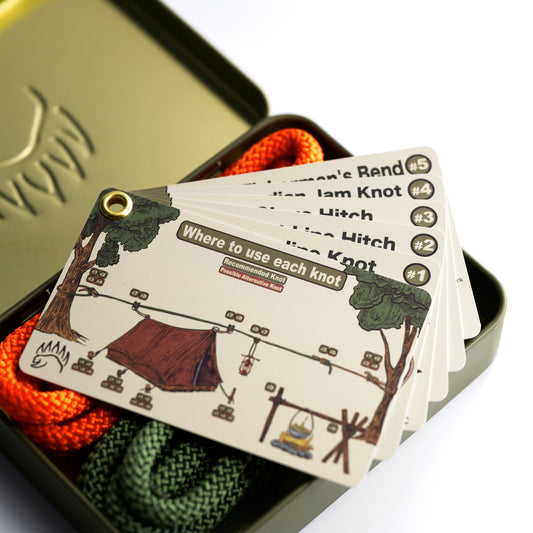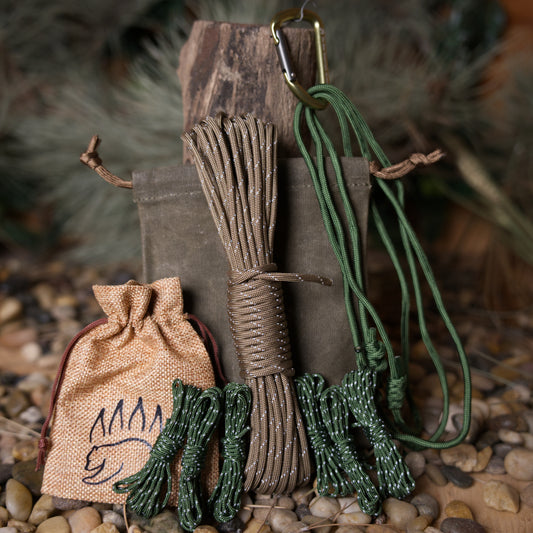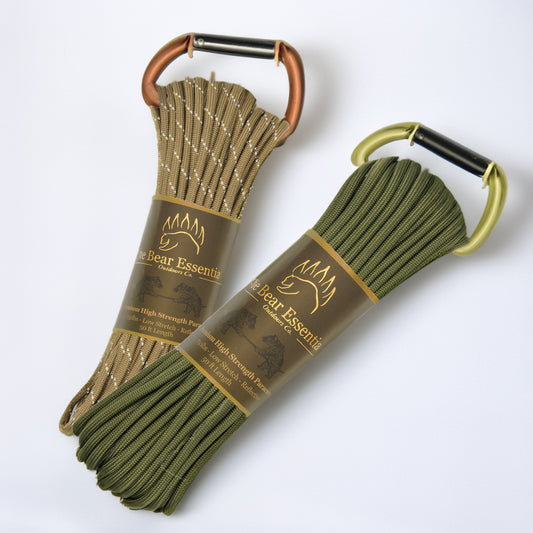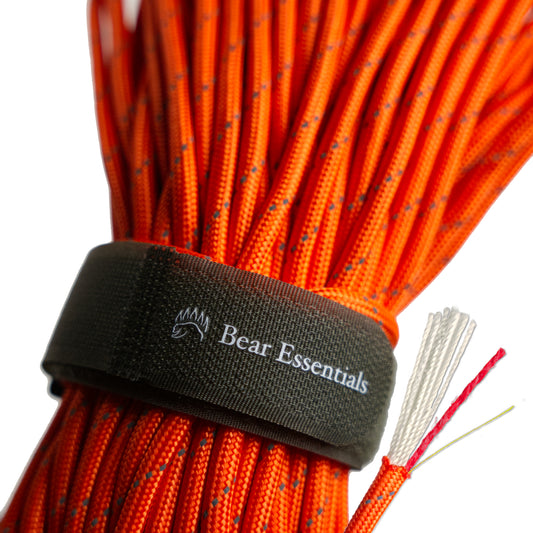How To Tie the Taut Line Hitch
Usage
The Taut Line Hitch is my favourite all-round knot (hitch) due to its wide range of uses. From making a secure anchor to having a handy adjustable tensioning line, this knot offers not only a reliable hold, but one that can be adjusted in place without having to retie it. From securing a tarp, to setting up a tent or hanging a clothesline, the Taught Line Hitch provides on-demand adjustability making it one of the "must haves" in your skill set.
Why Learn the Knot
The Taught Line excels in camping, bushcraft, and scouting situations, its simple “two in, one out” wrap style makes it easy to remember and easy to tie, even with the added challenge of wearing gloves or mitts. Adjustable to your needs in the moment, you can fine tune the tension of your line by sliding the knot up or down the rope until you achieve the right amount. It’s a time-saver that remains one of the most practical knots you can learn.
Common Uses
- Camping and Bushcraft
- Tarp Setup: Provides quick adjustability for securing tarp corners.
- Rainfly Tension: Keeps tent rainfly taut, even when the stakes may shift or loosen.
- Hanging Gear: Acts as an adjustable hanger to hold items like pots or bags at different heights over a fire or off the ground.
- Securing the ends of a rope- no matter what it’s attached to!
- Scouts
- Tent Guy Lines: Frequently used by scouts to secure and adjust tent guylines.
- General Outdoor Use: Tying down loads, creating adjustable lines for various camp structures.
- Other Uses
- Arborist Climbing: Arborists use this knot to secure climbing ropes on trees.
- Aircraft Tie Downs: For adjusting moorings in areas with tidal or weather fluctuations.
- Vehicle Load Security: Allows for secure, adjustable lines on vehicle cargo.
ABOK Number
(Ashley Book of Knots)
Other Names
Category
|
Notable Features
- Adjustable: The knot can slide up and down the standing part, allowing quick tension adjustments.
- Easy to Tie and Untie: Especially convenient with gloves, making it suitable for cold weather use.
- Quick Release Option: A variation can be tied with a quick-release bight to make untying even faster.
Similar Knots
Midshipman’s Hitch vs. The Taut Line Hitch
- Pros: Offers greater security and stability than the Taut Line Hitch, making it ideal for more demanding applications.
- Cons: Slightly more complex to tie and less intuitive for beginners.
Magnus Hitch vs. The Taut Line Hitch
- Pros: Very similar in function, providing an adjustable loop that holds well under tension.
- Cons: Can be less secure if tied incorrectly, as it may slip under heavy load.
Rolling Hitch vs. The Taut Line Hitch
- Pros: Provides excellent hold on slippery surfaces and remains secure under tension, making it ideal for more challenging conditions.
- Cons: More complex than the Taut Line Hitch, requiring practice to tie correctly.
Farrimond Friction Hitch vs. The Taut Line Hitch
- Pros: Compared to the farrimond friction hitch, it is very secure, with easy tensioning and release, making it ideal for guylines and tarp setups.
- Cons: Less widely known, and it can be trickier to tie than the Taut Line Hitch for beginners.
Klemheist Hitch vs. The Taut Line Hitch
- Pros: Excellent hold on synthetic and slippery ropes; it grips well under load and is easy to slide when unloaded.
- Cons: Requires the use of a loop or sling rather than a free rope end, limiting its applications compared to the Taut Line Hitch.
Adjustable Grip Hitch vs. The Taut Line Hitch
- Pros: Extremely versatile with a strong grip under load, adjustable for various applications and holds well on synthetic ropes.
- Cons: Less common than the Taut Line Hitch and can be more challenging to learn, requiring more wraps to secure correctly.
History
The Taut Line Hitch has deep roots in scouting and camping, with variations appearing across different manuals over the years. Originally, it was related closely to the Midshipman’s Hitch and the Rolling Hitch, all providing similar functionality. However, due to its simplicity, the Taut Line Hitch quickly became the go-to knot for quick adjustments and ease of use in outdoor activities. Its importance has only grown, making it a foundational skill for campers, scouts, and outdoor enthusiasts.
Security Level
The Taut Line Hitch is secure enough for most outdoor applications but should not be used for critical loads where slippage would be dangerous. The Midshipman’s Hitch is more secure for high-stakes applications.
Downsides
While versatile, the Taut Line Hitch can lose its grip under extreme tension or if not tied carefully, particularly on slippery ropes. It may also loosen over time, so frequent checking is recommended in windy or high-activity situations.
Structure
- Step 1: Wrap the rope around an anchor (such as a tree or pole) and cross the working end over the standing line.
- Step 2: Make a second wrap around the standing line in the same direction as the first, creating an “inside” wrap.
- Step 3: Add a third wrap, but this time on the outside of the loop.
- Step 4: Pull both ends tight, adjusting as needed for a secure hold.
- Step 5 (optional): For a quick-release version, create a bight in the final wrap and pull it through the loop instead of the end.
FAQ
What are the main uses of the Taut Line Hitch?
It’s primarily used for adjustable tension in lines, especially for tent guylines, tarp tie-outs, and securing loads where you may need to fine tune the tension on your line.
Can I use the Taut Line Hitch for climbing?
No, this hitch is not secure enough for critical applications like climbing. Knots like the Midshipman’s Hitch or a Prusik Knot are more appropriate. Visit the prusik knot tutorial.
How is the Taut Line Hitch different from the Midshipman’s Hitch?
The Midshipman’s Hitch is slightly more secure, especially under heavy load, but is a bit more complex to tie. The Taut Line Hitch is easier to learn and is widely used for camping and scouting.
Can the Taut Line Hitch be tied in slippery or synthetic ropes?
Yes, but it may require additional wraps or a quick-release variation for extra security, especially on very slippery cords.
What is the best way to tie a quick-release Taut Line Hitch?
To create a quick-release version, form a bight in the final wrap and pull it through the loop. This lets you release the hitch with a simple pull on the tag end.
Important Notes on Safety
The Taut Line Hitch is best used for temporary applications and light-duty tasks. Always double-check that the hitch is holding securely, especially on smooth or synthetic ropes, as it may loosen over time. Avoid using this hitch for critical applications where slippage could lead to injury.









